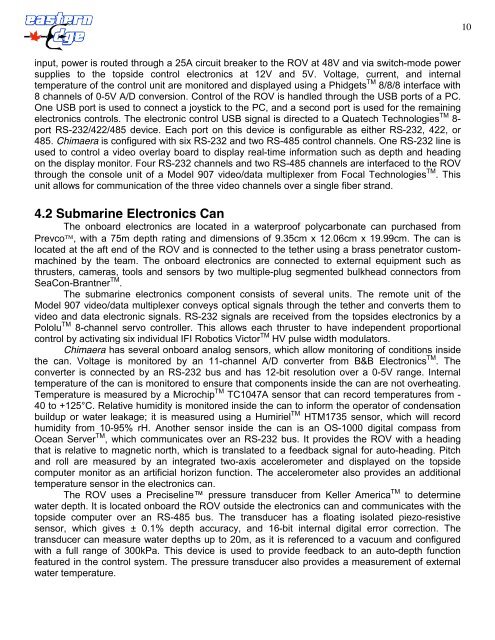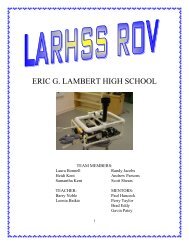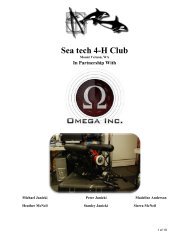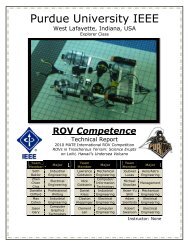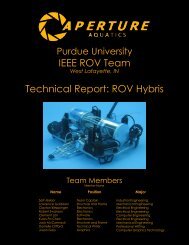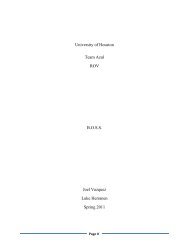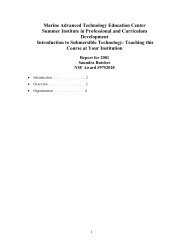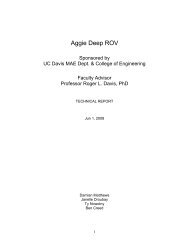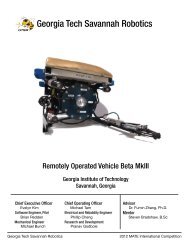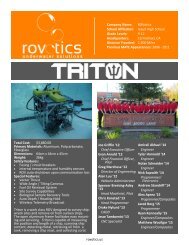Technical Report - the Marine Advanced Technology Education ...
Technical Report - the Marine Advanced Technology Education ...
Technical Report - the Marine Advanced Technology Education ...
Create successful ePaper yourself
Turn your PDF publications into a flip-book with our unique Google optimized e-Paper software.
10<br />
input, power is routed through a 25A circuit breaker to <strong>the</strong> ROV at 48V and via switch-mode power<br />
supplies to <strong>the</strong> topside control electronics at 12V and 5V. Voltage, current, and internal<br />
temperature of <strong>the</strong> control unit are monitored and displayed using a Phidgets TM 8/8/8 interface with<br />
8 channels of 0-5V A/D conversion. Control of <strong>the</strong> ROV is handled through <strong>the</strong> USB ports of a PC.<br />
One USB port is used to connect a joystick to <strong>the</strong> PC, and a second port is used for <strong>the</strong> remaining<br />
electronics controls. The electronic control USB signal is directed to a Quatech Technologies TM 8-<br />
port RS-232/422/485 device. Each port on this device is configurable as ei<strong>the</strong>r RS-232, 422, or<br />
485. Chimaera is configured with six RS-232 and two RS-485 control channels. One RS-232 line is<br />
used to control a video overlay board to display real-time information such as depth and heading<br />
on <strong>the</strong> display monitor. Four RS-232 channels and two RS-485 channels are interfaced to <strong>the</strong> ROV<br />
through <strong>the</strong> console unit of a Model 907 video/data multiplexer from Focal Technologies TM . This<br />
unit allows for communication of <strong>the</strong> three video channels over a single fiber strand.<br />
4.2 Submarine Electronics Can<br />
The onboard electronics are located in a waterproof polycarbonate can purchased from<br />
Prevco, with a 75m depth rating and dimensions of 9.35cm x 12.06cm x 19.99cm. The can is<br />
located at <strong>the</strong> aft end of <strong>the</strong> ROV and is connected to <strong>the</strong> te<strong>the</strong>r using a brass penetrator custommachined<br />
by <strong>the</strong> team. The onboard electronics are connected to external equipment such as<br />
thrusters, cameras, tools and sensors by two multiple-plug segmented bulkhead connectors from<br />
SeaCon-Brantner TM .<br />
The submarine electronics component consists of several units. The remote unit of <strong>the</strong><br />
Model 907 video/data multiplexer conveys optical signals through <strong>the</strong> te<strong>the</strong>r and converts <strong>the</strong>m to<br />
video and data electronic signals. RS-232 signals are received from <strong>the</strong> topsides electronics by a<br />
Pololu TM 8-channel servo controller. This allows each thruster to have independent proportional<br />
control by activating six individual IFI Robotics Victor TM HV pulse width modulators.<br />
Chimaera has several onboard analog sensors, which allow monitoring of conditions inside<br />
<strong>the</strong> can. Voltage is monitored by an 11-channel A/D converter from B&B Electronics TM . The<br />
converter is connected by an RS-232 bus and has 12-bit resolution over a 0-5V range. Internal<br />
temperature of <strong>the</strong> can is monitored to ensure that components inside <strong>the</strong> can are not overheating.<br />
Temperature is measured by a Microchip TM TC1047A sensor that can record temperatures from -<br />
40 to +125°C. Relative humidity is monitored inside <strong>the</strong> can to inform <strong>the</strong> operator of condensation<br />
buildup or water leakage; it is measured using a Humiriel TM HTM1735 sensor, which will record<br />
humidity from 10-95% rH. Ano<strong>the</strong>r sensor inside <strong>the</strong> can is an OS-1000 digital compass from<br />
Ocean Server TM , which communicates over an RS-232 bus. It provides <strong>the</strong> ROV with a heading<br />
that is relative to magnetic north, which is translated to a feedback signal for auto-heading. Pitch<br />
and roll are measured by an integrated two-axis accelerometer and displayed on <strong>the</strong> topside<br />
computer monitor as an artificial horizon function. The accelerometer also provides an additional<br />
temperature sensor in <strong>the</strong> electronics can.<br />
The ROV uses a Preciseline pressure transducer from Keller America TM to determine<br />
water depth. It is located onboard <strong>the</strong> ROV outside <strong>the</strong> electronics can and communicates with <strong>the</strong><br />
topside computer over an RS-485 bus. The transducer has a floating isolated piezo-resistive<br />
sensor, which gives ± 0.1% depth accuracy, and 16-bit internal digital error correction. The<br />
transducer can measure water depths up to 20m, as it is referenced to a vacuum and configured<br />
with a full range of 300kPa. This device is used to provide feedback to an auto-depth function<br />
featured in <strong>the</strong> control system. The pressure transducer also provides a measurement of external<br />
water temperature.


